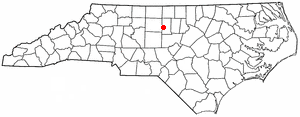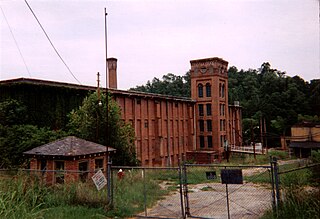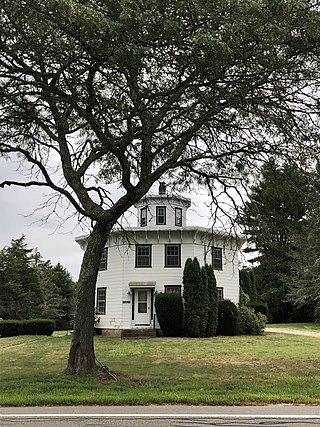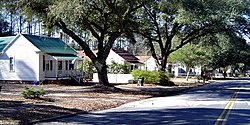
Aiken County is a county in the U.S. state of South Carolina. As of the 2020 census, its population was 168,808. Its county seat and largest community is Aiken. Aiken County is a part of the Augusta-Richmond County, GA-SC Metropolitan Statistical Area. It is mostly in the Sandhills region, with the northern parts reaching in the Piedmont and southern parts reaching into the Coastal Plain.

Alamance is a village in Alamance County, North Carolina, United States. It is part of the Burlington, North Carolina Metropolitan Statistical Area. The population was 951 at the 2010 census, up from 310 at the 2000 census.

Edgefield is a town in Edgefield County, South Carolina, United States. The population was 4,750 at the 2010 census. It is the county seat of Edgefield County.

Seneca is a city in Oconee County, South Carolina, United States. The population was 8,102 at the 2010 census. It is the principal city of the Seneca Micropolitan Statistical Area, an (MSA) that includes all of Oconee County, and that is included within the greater Greenville-Spartanburg-Anderson, South Carolina Combined Statistical Area. Seneca was named for the nearby Cherokee town of Isunigu, which English colonists knew as "Seneca Town".

Ware Shoals is a town in Abbeville, Greenwood, and Laurens counties in the U.S. state of South Carolina, along the Saluda River. Ware Shoals has a population of 1,607 according to the 2020 United States Census.

Graniteville is a census-designated place (CDP) in Aiken County, South Carolina, United States. The population was 2,614 at the 2010 census. It lies along U.S. Route 1, five miles (8.0 km) west of Aiken in Horse Creek Valley, which originates in the nearby town of Vaucluse.

William Gregg was an ardent advocate of industrialization in the antebellum Southern United States and the founder of the Graniteville Mill, the largest textile mill in South Carolina during the antebellum period. Gregg was a revolutionary figure in the textile industry. His practice of having his employees live in company-owned homes became common.

The Sibley Mill is a historic building located on the Augusta Canal at 1717 Goodrich Street near downtown Augusta, Georgia, United States. Designed by Jones S. Davis, it was built on a site previously occupied by the Confederate Powderworks, and was completed in 1882. While the interior is typical of any textile mill of the period, its imposing exterior is notable for an ornate style variously described as eclectic and neo-gothic. Textile products were produced there until 2006, since when the building has been unoccupied. The mill was built to operate on hydropower, and continues to generate electricity today.
Warrenville is a census-designated place (CDP) in Aiken County, South Carolina, United States. The population was 1,233 at the 2010 census. It is located just south of Graniteville and is part of the Augusta, Georgia metropolitan area. Warrenville is located in historic Horse Creek Valley.

Newry is a census-designated place in Oconee County, South Carolina. According to the 2020 United States Census, the population of the CDP was 199.

The Graniteville Historic District encompasses one of the first textile company towns to be established in the Southern United States. Built in the late 1840s by William Gregg near Aiken, South Carolina, and now known as Graniteville, it was modeled after New England mill towns. Gregg used the success of this enterprise to advocate for the industrialization of the South, laying the groundwork for its eventual domination of the American textile industry. The district, which includes the original canal, mill building, mill worker housing, and a period church, was designated a National Historic Landmark District in 1978.

Carolina is a village that straddles the border of the towns of Charlestown and Richmond on the Pawcatuck River in Washington County, Rhode Island. Rhode Island Route 112 passes through the village. Carolina is identified as a census-designated place, with a population of 970 at the 2010 census.

The economy of South Carolina was ranked the 25th largest in the United States based on gross domestic product in 2022. Tourism, centered around Myrtle Beach, Charleston, and Hilton Head Island, is the state's largest industry. The state's other major economic sector is advanced manufacturing located primarily in the Upstate and the Lowcountry.

Horse Creek Valley is a geographic area along Horse Creek, a tributary of the Savannah River. It lies within present-day Aiken County, South Carolina. The area is alternately referred to as "Midland Valley". Rising near Vaucluse, South Carolina, Horse Creek enters the Savannah two miles downstream of downtown Augusta, Georgia. Other communities along Horse Creek include Graniteville, Warrenville, Gloverville, Langley, Burnettown, Bath, and Clearwater. While Horse Creek itself is rather insignificant, its potential for water power led to early examples of Southern industrialization, including a textile mill at Vaucluse (1830) and William Gregg's Graniteville Mill (1845). The textile industry continued to play a primary role until the Graniteville Train Derailment and final closure of the Graniteville Mill in 2006.

The Fall River Manufactory was the first cotton mill to be constructed across the Quequechan River in Fall River, Massachusetts, United States. It was also the first successful textile mill in the area.

The Vaucluse Historic District, located in Vaucluse, South Carolina in Aiken County. The district includes the mill, number of accompanying buildings, and over eighty mill village homes. The district is noteworthy in that it is considered to be oldest mill village in the state. No less significant, the mill building, completed in 1877, was based on the plans of engineers A. D. Lockwood & Company of Providence, Rhode Island. The Lockwood successor firm, Lockwood, Greene & Company, would later design around fifty of South Carolina's textile manufacturing facilities. The Vancluse Historic District was listed in the National Register of Historic Places on May 7, 1996.

The Avondale Mills were a system of textile mills located predominantly in Alabama, but also in Georgia and South Carolina, with headquarters in Birmingham, and later in Sylacauga, Alabama. The Birmingham neighborhood of Avondale was chosen to be the site of the first mill, hence the naming of the company. Founded in 1897, the mills employed thousands of Alabamians throughout its 109-year history until they closed in 2006. Avondale Mills was founded in 1897 by a consortium of investors including the Trainer family of Chester, Pennsylvania, the future governor of Alabama, Braxton Bragg Comer, and a group of Birmingham civic leaders including Frederick Mitchell Jackson Sr.

South Carolina Highway 191 (SC 191) is a 21.930-mile-long (35.293 km) state highway in the U.S. state of South Carolina. The highway connects Warrenville and Johnston.

The Hickman Mill Historic District encompasses an early 20th-century textile mill complex in Graniteville, South Carolina. It is located just south of the older Graniteville Mill, and is bounded on the north by Marshall Street, the east by Canal Street, and the south by Hard Street. The complex includes a large brick mill building, and the Classical Revival Hickman Memorial Hall. The mill was built by Tracy Hickman, whose father had succeeded William Gregg at the helm of the Graniteville Mill. The hall was built in 1908 as a place to provide recreational and cultural opportunities to the mill workers.
Dudley Shoals is a populated place and former village located in the Little River township of Caldwell County, North Carolina, United States. It is located about 10 miles (16.09 km) northeast of the town of Granite Falls.





















